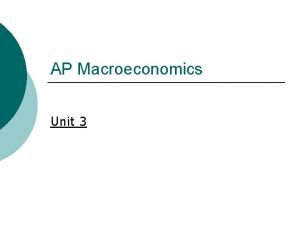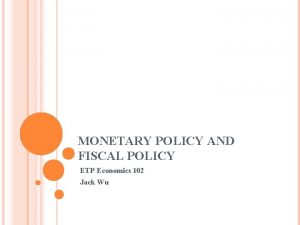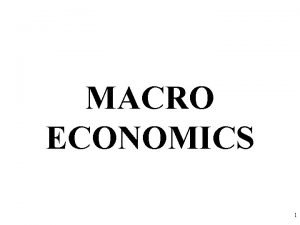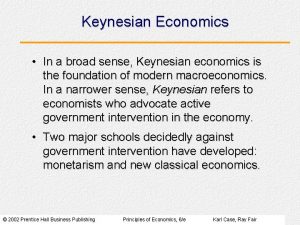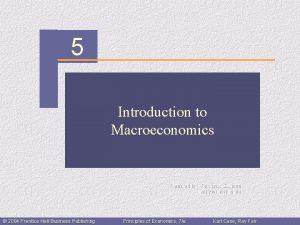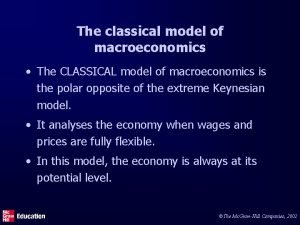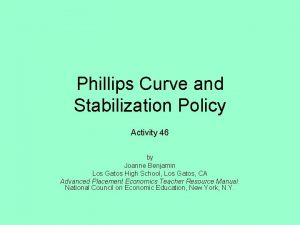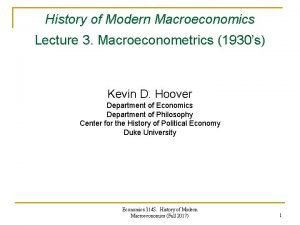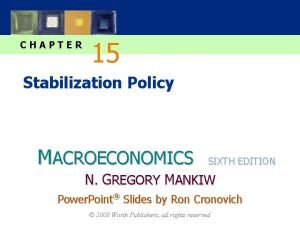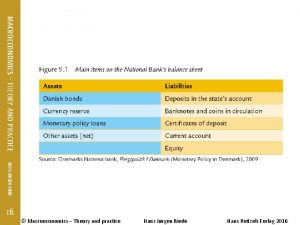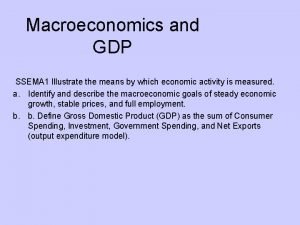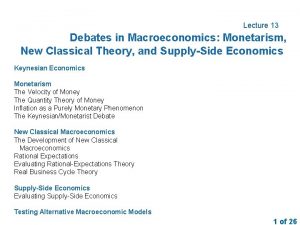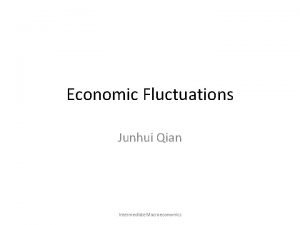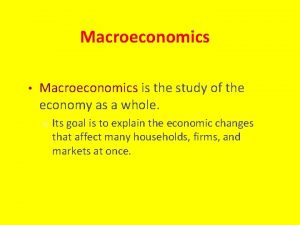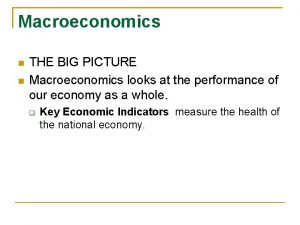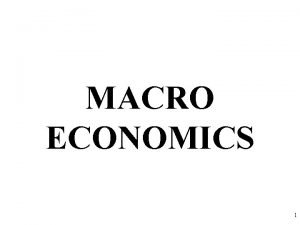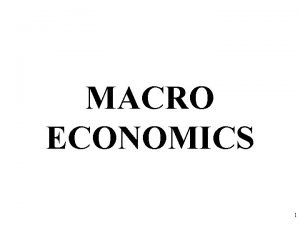AP Macroeconomics Unit 3 AP Macroeconomics Unit 3
















































- Slides: 48

AP Macroeconomics Unit 3

AP Macroeconomics Unit 3 Lesson 1

Aggregate Demand ¡ Schedule showing quantity demanded for all goods/services (measured as Real GDP) in the economy at each price level (measured with a price index).

Aggregate Demand Why is the aggregate demand curve downward sloping? ¡ Wealth Effect: “If price levels go down, the money I have has more purchasing power, so I buy more stuff. ” ¡

Aggregate Demand Why downward sloping? ¡ Interest-Rate Effect: ** “As price levels rise, bank acct. balances fall, and interest rates… ¡ rise, which lowers investment, causing Real GDP to… ¡ FALL!” ¡

Aggregate Demand Why downward sloping? ¡ Foreign Purchases Effect: “As U. S. price levels rise relative to other countries, they demand less of our stuff, causing real GDP to fall. ” ¡

Aggregate Demand ¡ The components of aggregate demand are the variables from the GDP expenditure model: l GDP=C+I+G+(X-M)

What causes AD to shift? ¡ Changes in C, I, G, or Nx ¡ Consumer Spending l l l consumer expectations wealth(change in stock P’s) debt affect DI taxes (fiscal policy) interest rates (monetary policy)

What causes AD to shift? ¡ Investment Spending l l l interest rates (monetary) profit expectations business taxes technology production capacity (excess causes I , AD shifts left)

What causes AD to shift? Interest rates are correlated inversely with Investment. ¡ Sketch this out! ¡ So, ceteris paribus, when i goes up, I goes down, bringing AD down also. ¡ Investment Demand Curve

What causes AD to shift? ¡ Changes in ¡ Gov’t Spending ¡ l ceteris paribus, if G increases, AD increases

Aggregate Demand What causes AD to shift? ¡ Changes in ¡ Net Exports ¡ l l an increase in foreign income will cause their demand for our stuff to increase, Nx , AD shifts right exchange rates: if the value of USD falls relative to other currencies, Nx , AD shifts right

¡ a 23 b

AP Macroeconomics Unit 3 Lesson 2

Aggregate Supply ¡ Schedule showing the amount of goods/services firms will produce at various price levels.

Aggregate Supply Three Views of A. S. : ¡ The vertical area represents full employment (Classical range). ¡ The flat area represents unused resources (Keynesian range). ¡

Aggregate Supply In the short-run, wages and prices are “sticky”. ¡ Examples: ¡ l l Even if prices are falling, workers are usually not very open to having their wages cut. Many businesses try to keep their prices stable. Frequently changing prices can make consumers mad.

Aggregate Supply ¡ ¡ ¡ Long-run aggregate-supply is vertical b/c, in the longrun, wages/prices are flexible (Classical). Also, in the long-run, a country’s production depends on its supplies of productive resources & technology; not price levels! LRAS represents full employment. Can production occur beyond LRAS? How?

Aggregate Supply ¡ Economic growth shifts LRAS rightward.

¡ From this point on we will use a “regular” AS curve.

Aggregate Supply What causes AS to shift? ¡ Changes in: ¡ l l Input costs Productivity Producer expectations Gov’t involvement Regulations ¡ Business Taxes ¡ Subsidies ¡

¡ a 24 b

AP Macroeconomics Unit 3 Lesson 3

Macroeconomic Equilibrium ¡ -is where shortrun aggregate supply and aggregate demand meet.

Macroeconomic Equilibrium Remember, business taxes cause AD to shift. Why? ¡ So, how would an increase in business taxes affect AD? AS? PL? RGDP? ¡

¡ A 25 b, c

Macroeconomic Equilibrium Long-run macroeconomic equilibrium ¡ -is where short-run aggregate supply, aggregate demand, and long-run aggregate supply meet. ¡

Macroeconomic Equilibrium ¡ ¡ ¡ In the long run, the economy always (and naturally) gravitates towards full employment levels of real GDP. SRAS (eventually) naturally shifts to bring equilibrium to full employment levels. But sometimes, we don’t want to wait around for this to occur!

Inflation Revisited Demand-Pull Inflation: an increase in AD “pulls” up the price level. ¡ Cost-Push Inflation: a decrease in AS “pushes” up the price level. ¡

Fiscal Policy ¡ Taxing/Spending for the purposes of affecting the economy. Typically, this results in a shift in the AD curve. l l expansionary: more spending, less taxes contractionary: less spending, more taxes discretionary: deliberate changes made by congress & president (i. e. stimulus bill) automatic: “built-in” stabilizers that are expansionary during recessions and/or contractionary during inflation (unemployment compensation)

a 28 ¡ a 30 b(fiscal policy), a 31 (1 page) ¡ hw: ch 20 pa (1, 2, ) ¡

AP Macroeconomics Unit 3 Lesson 4

“Multiplier” and “Crowding Out” Effects Disposable income has a big effect on AD. ¡ Higher disposable income = higher AD. . . ¡. . . because the biggest determinant of consumption is disposable income. ¡ Q: What do people do with their income? ¡ A: Spend it or save it ¡

“Multiplier” and “Crowding Out” Effects ¡ ¡ ¡ ¡ Gross Domestic Product - Consumption of fixed capital Net Domestic Product + Net American income earned abroad - Indirect business taxes (sales taxes) National Income (Income Earned) - Social Security Contributions - Corporate Income Taxes - Undistributed corporate profits + Transfer payments Personal Income (Income Received) - Personal Taxes Disposable Income

“Multiplier” and “Crowding Out” Effects Consumption (C) + Savings (S) = Disposable Income (DI) ¡ The relationship between C, S & Y goes like this: ¡ l l As Y increases, C & S increase, but C increases at a slower rate and S increases at a faster rate Dissaving if C > DI. (S is negative)

“Multiplier” and “Crowding Out” Effects ¡ Average Propensity to Consume (APC)=C/Y l ¡ This is the fraction of total income consumed Average Propensity to Save (APS)= S/Y l This is the fraction of total income that is saved. APC + APS = 1 ¡ Marginal Prop. to Cons. -the fraction of additional Y consumed rather than saved. ¡ MPC = C/ Y ¡ MPS = S/ Y ¡ MPC + MPS = 1 ¡

“Multiplier” and “Crowding Out” Effects ¡ Consumption Schedules l link Search for: consumption schedule graph ¡ Things other than income affect consumption, and shift the consumption line up or down. ¡ l l i wealth/indebtedness consumer confidence/expectations PL

“Multiplier” and “Crowding Out” Effects ¡ Consumption Schedules assignment l l When the consumption schedule shifts upward, what happens to the savings schedule? Why? When the slope of the consumption line increases (becomes more steep), what happens to the slope of the savings schedule? What terms do we use for these two slopes?

“Multiplier” and “Crowding Out” Effects The Multiplier Effect ¡ Individual components of AD have a multiplier effect on AD; when one increases by a $, AD increases by > $. ¡ Who benefits when the gov’t buys $20 billion in planes from Boeing? ¡ Multiplier = 1 / (1 -MPC) ¡ When C, I, G, or Nx change by X, AD changes by ¡ X [1/(1 -MPC)] ¡

“Multiplier” and “Crowding Out” Effects The Multiplier Effect ¡ Taxes have a different multiplier, b/c taxes affect income. ¡ Tax multiplier: -MPC/(1 -MPC) ¡ ¡ Balanced budget multiplier l What happens when the gov’t spends the same amount as it taxes?

“Multiplier” & “Crowding Out” Effects A new graph (sort of)! ¡ The Money Market shows how the “price” of money, the interest rate, adjusts to balance the supply of and demand for money. ¡ The money supply is fixed at any one point in time, and therefore is represented by a vertical line. ¡ The Money Market

“Multiplier” & “Crowding Out” Effects Remember the interestrate effect? ¡ Can it be explained through the money market? ¡ The Money Market

“Multiplier” & “Crowding Out” Effects Several things can cause Dm to shift, but for now we’ll just focus on one; G. ¡ Q: If gov’t increases spending but doesn’t collect enough taxes to cover the spending, where does it get the money? ¡ A: By borrowing (mostly) ¡ The Money Market

“Multiplier” & “Crowding Out” Effects Q: When the government borrows, what happens in the money market? ¡ A: Dm shifts right, and interest rates rise. ¡ The Money Market

“Multiplier” & “Crowding Out” Effects Q: Are there portions of output (RGDP) that are influenced by interest rates? ¡ A: I, and to a lesser extent, C ¡ We call these “interest rate-sensitive investment and consumption. ” ¡ The Money Market

“Multiplier” & “Crowding Out” Effects The Crowding Out Effect ¡ Gov’t spending “crowds out” i-sensitive I & C. ¡ Implications for AD? ¡ GDP = C+I+G+Xn ¡ The crowding out effect partially offsets the impact of the increase in G. ¡

“Net Export” Effect ¡ If the government enters the money market to finance the deficit, interest rates will rise. The higher interest rate causes the dollar to appreciate. Therefore, net exports decline, and aggregate demand decreases, which offsets the effects of expansionary fiscal policy.

¡ Done!
 Unit 5 macroeconomics lesson 2 activity 45
Unit 5 macroeconomics lesson 2 activity 45 Unit 3 ap macroeconomics
Unit 3 ap macroeconomics Transfer payments
Transfer payments Components of macroeconomics
Components of macroeconomics Crowding out effect macroeconomics
Crowding out effect macroeconomics Crowding out effect macroeconomics
Crowding out effect macroeconomics Limitations of macroeconomics
Limitations of macroeconomics Structural rate of unemployment
Structural rate of unemployment Venn diagram
Venn diagram Nominal gdp formula
Nominal gdp formula New classical macroeconomics
New classical macroeconomics New classical macroeconomics
New classical macroeconomics Crowding out effect of fiscal policy
Crowding out effect of fiscal policy 2012 macroeconomics frq
2012 macroeconomics frq Calculate gdp circular flow diagram
Calculate gdp circular flow diagram Ap macroeconomics-percentage for a 5
Ap macroeconomics-percentage for a 5 Chapter 31 open economy macroeconomics
Chapter 31 open economy macroeconomics Macroeconomic deals withसमग्रलक्षी
Macroeconomic deals withसमग्रलक्षी Supply side economics
Supply side economics New classical and new keynesian macroeconomics
New classical and new keynesian macroeconomics Ap macroeconomics cheat sheet
Ap macroeconomics cheat sheet Ap macro graphs
Ap macro graphs Macroeconomics
Macroeconomics Aw phillips curve
Aw phillips curve Components of macroeconomics
Components of macroeconomics Parkin macroeconomics 13th edition pdf
Parkin macroeconomics 13th edition pdf Macroeconomics
Macroeconomics Ap macro units
Ap macro units Macroeconomics chapter 7
Macroeconomics chapter 7 Macroeconometrics
Macroeconometrics Growth rate nominal gdp formula
Growth rate nominal gdp formula Macroeconomics chapter 8
Macroeconomics chapter 8 Macroeconomics
Macroeconomics Macroeconomics
Macroeconomics Micro macro economics
Micro macro economics Macroeconomics by mankiw
Macroeconomics by mankiw Macroeconomics
Macroeconomics Macroeconomics
Macroeconomics Nicepp
Nicepp Macroeconomics
Macroeconomics Macroeconomics
Macroeconomics Principles of macroeconomics case fair oster
Principles of macroeconomics case fair oster Macroeconomics theory and practice
Macroeconomics theory and practice Macroeconomics
Macroeconomics Branch of economics
Branch of economics Gross domestic product macroeconomics
Gross domestic product macroeconomics Macroeconomics
Macroeconomics Intermediate macroeconomics mankiw
Intermediate macroeconomics mankiw Macroeconomics
Macroeconomics

